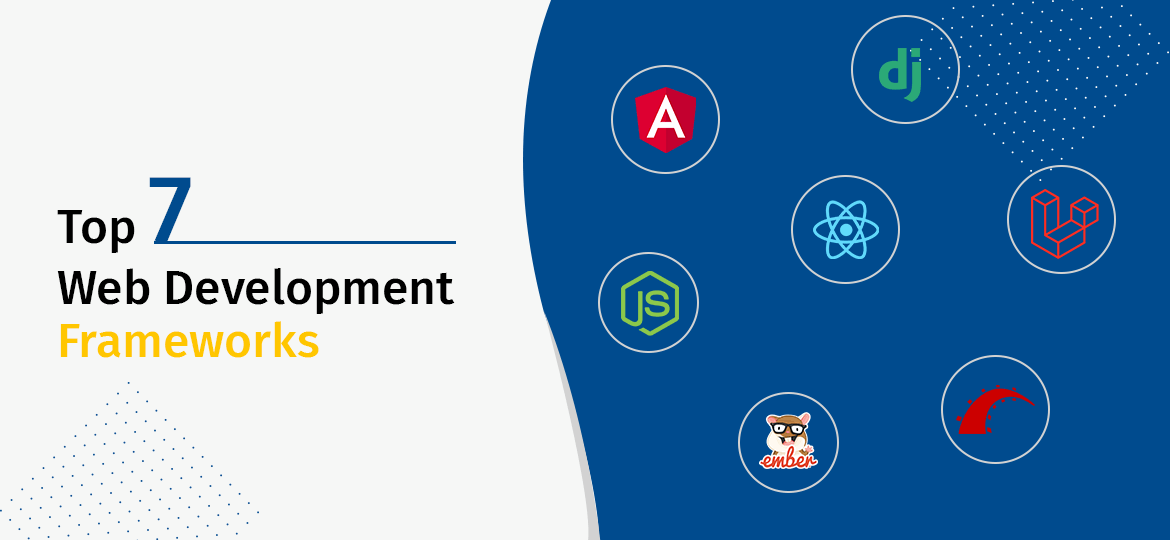
As a web developer, you might possess an Athenaeum of preferred web development frameworks. But if you are amongst the one who along with personal comfort looks for the latest trends, to move at the momentum parallel to technology, you need to be aware of the latest web development technologies and new web development frameworks and eventually implement them. Therefore, here we present the list of time and trend-friendly frameworks with their respective pros and cons.
DJANGO
Django is avant-garde and out-of-the-box open-source framework, congenial up to Python version 3.4. It’s armed with templates, server-side, and admin panel, to form the website without any rephrasing of the code. It also restrains you from using a third-party framework to figure out a poignant website. Moreover, Django uses a model template view to separate logic and views. Django has also been exercised by thousands of medium websites and startups for its receptiveness, sufficient functionality, and good documentation.
ADVANTAGES:
- Ease of ORM Object Rational Mapper to map projects with the database table.
- Its common database engines (MySQL, PostgreSQL, SQLite, Oracle, SQL Server, DB2, and others with additional drivers), make migration between them very simple.
- Self-equipped with a lightweight development server.
DISADVANTAGES:
- Because of its concentrated development speed, it’s crucial to integrate new shiny buzzwords into the system.
- A mammoth framework
- Comparatively, large structures even if on making a simple landing page.
- Complex

Ruby on Rails (RoR)
RoR was spawned to make the coding of web-based applications Elementary and agile. RoR clips a fundamental rule: Convention over Configuration. Rails is a helpful tool for professionals to construct varied web applications.
ADVANTAGES:
- Convention over configuration gives the ease to write much less code.
- Rails provide a default structure for the database, web service, and web pages.
- Easy to use relational and non-relational database engines with drivers originally included.
DISADVANTAGES:
- A lot to learn for first-time users
- Ruby requires more server capacity and resources.
EXPRESS
Express.js is an open-source framework for Node.js to form simple web applications with server-side and API. It’s a canonical server framework for projects which use javascript. PayPal and MySpace are its users.
ADVANTAGES:
- Uncomplicated interface to create websites and web apps.
- It is very pliable and pluggable.
DISADVANTAGES:
- Requires the installation of additional libraries and packages for effective development.
- Compatibility issues.
- A single computation blocks other computation requests until completed.

ANGULAR
An open-source framework designed for single-page web apps and mobile app development, using MVC architectural motif. Angular is an evolution of AngularJS and a completely new framework. You can use it for common websites or landing pages, but not for those you want to see on top of Google or Yahoo searches. It’s not SEO friendly.
ADVANTAGES:
- Uses dynamic data to create a web application as opposed to the static HTML website.
- Based on components (stored in modules) that define what the web page will display.
- Can easily link as many components as needed to a web page by alternating different custom tags.
- Provides an online update view for events, logic stored in components, and changed data.
DISADVANTAGES:
- Zero backward compatibility to Angular 1. x
- One needs to get accustomed to typescript first, before using it.
- It is not SEO-friendly.
REACT
React is devised and backed by Facebook. Although React is not a full-stack framework, it ensures only View-level (templating language) and certain callback functions to interpose HTML code, it’s a powerful front-end tool.
ADVANTAGES:
- Compatible tool for fast view renders.
- React allows to re-render one element of the whole set of DOM elements
- Compatible with Virtual DOM.
- Freedom to build a whole HTML page with each element as a single component (buttons, headers, checkboxes, lists, tables, etc) defining their view and behavior in corresponding js files.
DISADVANTAGE:
- Not possible to create a powerful application with the full-featured server-side.
- The complexity involved in moving complex designs from Photoshop or any sketch to JSX files.
Related: THE ALL-IMPORTANT 13 MOBILE APP TRENDS FOR 2017
VUE.js
Vue is a JavaScript library that ensures a View Model layer of the MVVM pattern. It connects a model and a view and thus provides two-way data binding. Vue is an open-source developed and supported by the community.
ADVANTAGES:
- One of Vue’s most significant attributes is its reactivity
- Too friendly for designers and easy to read.
- Fast UI development.
DISADVANTAGES:
- Minimal features “in the box”
- Less of documentation and plugins in comparison to competitors.
METEOR
Meteor is a full-stack framework that makes use of javascript both for the front end and for backend designs, for developing real-time applications for web and mobile. One simply needs to build a normal web application with Meteor and it is automatically real-time. It works on Node.
ADVANTAGES:
- A front-end developer can easily work on the back-end with Meteor without switching between Ruby/Python/PHP or any other language.
- One code is supported on a client and a server.
- No need to use REST to get data.
- Provides real-time updates.
- The meteor has a complete autonomous app compiler.
DISADVANTAGES:
- Additional node modules are needed while developing, so it will be necessary to pay attention to their updates and compatibility.
- It only works well with Mongo DB DDP and not with anyone else.
- Has to be used for the whole app, and not just for the front or backend.

Concetto Labs provides high-quality mobile application development as well as competitive php development frameworks through the use of the latest technologies. We provide a one-stop solution for all IT-related services.







 Indonesia
Indonesia
 Botswana
Botswana
 USA
USA
 Italy
Italy
 Panama
Panama




 USA
USA UK
UK Saudi Arabia
Saudi Arabia Norway
Norway India
India Australia
Australia